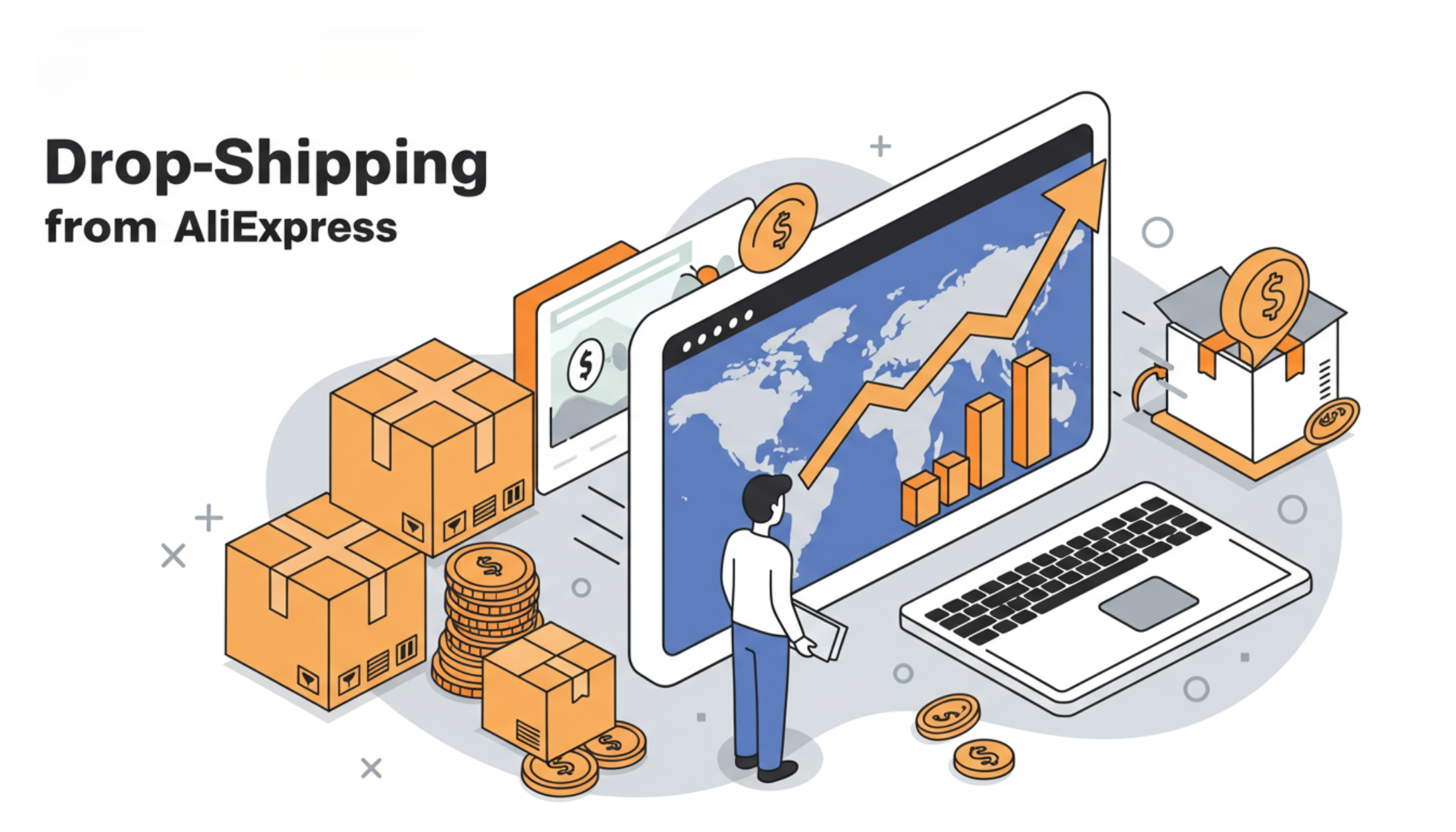Table of Contents
Introduction
Can dropshipping be a career? Many have wondered about this, and we’re here to break it down for you. Dropshipping is when you sell products online without having them in your possession. It sounds easy, but it’s a real business that needs your time and effort.We will understand more about dropshipping in the latter part.
We’ll explore the world of dropshipping, why some people struggle, and whether it’s the right choice for everyone. While it might look like a quick way to make money, the reality is that dropshipping requires hard work.
We’ll navigate the essentials, debunk common misconceptions, and evaluate whether dropshipping suits everyone. Our goal is to offer a clear, accessible perspective on whether this model can truly evolve into a sustainable and rewarding career path. Let’s start understanding dropshipping from the root to stem.
What is Dropshipping Business model?
Dropshipping business model is a method in which a seller showcases products online without the need to maintain any inventory. Instead, the seller enters into an agreement with a supplier. When a customer makes a purchase, the seller procures the product from the supplier, who then ships it directly to the customer. In essence, the seller acts as an intermediary connecting the buyer with the supplier.
What is a Dropshipper?
A dropshipper is an individual or business that engages in the practice of dropshipping. In dropshipping, the dropshipper is responsible for listing and selling products to customers through an online store or platform, but they do not physically hold the inventory. Instead, when a customer places an order, the dropshipper purchases the product from a supplier or wholesaler who then ships the product directly to the customer. Essentially, a dropshipper acts as an intermediary between the buyer and the supplier, handling the marketing and sales aspects of the business while outsourcing the storage and shipping of products to the supplier.
Can dropshipping be a Career?
Thinking of making dropshipping your career?Here we will find out whether dropshipping can become a full-fledged profession. We’ll examine the benefits it offers, the hurdles you might encounter, and whether it’s the right choice for your long-term goals.Let’s get started
A. Advantages and opportunities
- No Inventory Management: Dropshipping eliminates the need for inventory management, making it an attractive option for those considering if dropshipping can be a career. You won’t have to worry about storing or tracking products, saving time and resources.
- Low Startup Costs: One of the appealing aspects when pondering if dropshipping can be a career is the minimal initial investment compared to traditional retail stores. You can start with relatively low capital, reducing financial barriers.
- No Product Handling: When exploring if dropshipping can be a career, it’s essential to note that you won’t be involved in producing, storing, or shipping products. This simplifies the operational aspect, allowing you to focus on other aspects of the business.
- Skills Development: Dropshipping offers the opportunity to learn valuable skills in e-commerce, marketing, and customer service. These skills can be transferable and beneficial for long-term career growth.
- Rapid Store Launch: You’ll appreciate the speed at which you can launch your online store. With the right approach, you can set up your dropshipping business quickly.
- Scalability: Dropshipping provides the potential for significant growth, addressing the question of whether it can be a long-term career. As your business expands, you can handle more products and reach a broader audience.
B. Challenges and risks
- Intense Competition: With the accessibility of dropshipping, the market can be highly competitive. The challenge is to find ways to stand out and offer unique value to customers.With effective planning, marketing strategies and excellent customer services you can certainly achieve success in dropshipping as a career.
- Thin Profit Margins: Dropshipping often involves lower profit margins compared to traditional retail. This challenge requires efficient cost management and effective pricing strategies.
- Supplier Reliability: Relying on suppliers means you’re dependent on their stock levels, shipping times, and product quality. Ensuring consistent supplier performance is essential.
- Marketing and Customer Acquisition: Attracting customers and driving traffic to your store can be challenging. Effective marketing strategies are crucial for success.
- Quality Control: Ensuring the quality of products from your suppliers is crucial to prevent customer dissatisfaction.For this you can be in touch with your customers and take review and feedback on a regular basis.
- Shipping Issues: Delays, lost packages, and shipping costs can impact customer satisfaction. Managing shipping logistics effectively is a challenge.
- Market Saturation: In some niches, market saturation can make it challenging to find profitable products. Research and niche selection become
C. Average Dropshipping Income: What to Expect
Dropshipping is an attractive e-commerce model due to its low overhead and flexibility. However, the average dropshipping income varies. Beginners usually earn between $200 to $3,000 per month, while experienced dropshippers can make over $10,000 monthly.Factors Influencing Earnings:
- Niche Selection: Profit margins depend heavily on choosing the right niche.
- Supplier Relationships: Strong partnerships can lead to better product deals and quality.
- Marketing Efforts: Robust marketing strategies are essential for driving traffic and sales.
While starting earnings may be modest, the potential for growth in dropshipping is significant. With persistence and strategic improvements, dropshippers can see a substantial increase in their income over time.
The global dropshipping market was valued at $225.99 billion in 2022. It’s expected to grow at a rate of 23.4% annually from 2023 to 2030. This growth is mainly driven by the increasing preference for online shopping and the growing trend of cross-border e-commerce.

Dropshipping Market By Product:

Dropshipping Market in America:

For more details visit here
Steps To start Dropshipping as a career
- Choose Your Niche: Decide what you want to sell online.
- Find Suppliers: Connect with the best dropshipping suppliers.
- Create Your Store: Set up an online store using platforms like Fathershops.
- List Products: Add the products you want to sell to your store.
- Market Your Store: Promote your store through social media and marketing.
- Handle Orders: When customers buy, place orders with your suppliers.
- Provide Good Service: Offer great customer support and manage returns.
- Grow Your Business: Keep improving and expanding your product range.
Dropshipping Success Stories
Articture
 Name of Store: Articture
Name of Store: Articture
Niche: Home Improvement
What they sell: Anything home accessories-related – from bath mats, to crockery, lights, and bed linens.
Traffic: 95.60k visitors / month
What marketing tactics they use:
- Professional high-end photography
- Active Instagram Marketing and Facebook Accounts
- Plenty of IG reels showing off products
- Private labeling
2. Cloudsharks
 Name of Store:Cloudsharks
Name of Store:Cloudsharks
Niche:Apparel
What they sell:Shark-shaped slides, and accessories
Traffic: 73.1k visitors / month
What marketing tactics they use:
- Strong branding throughout website (brand appeal)
- Branded products with visible tags (private labeling)
- Presence on a wide range of social channels
3. Sleepband
 Name of Store:Sleepbzzz
Name of Store:Sleepbzzz
Niche: Sleep Aids
What they sell: Bluetooth sleep headphones, and other sleep accessories
Traffic: 91.1k visitors / month
What marketing tactics they use:
- Strong focus on one product with a very specific pain point
- Capitalizing on Influencer Marketing
- Use of testimonials and press mentions (social proof)
4. Fruity Bullet
 Name of Store:Fruity Bullet
Name of Store:Fruity Bullet
Niche: Home food processing equipment
What they sell: Portable food blenders
Traffic: 77.4k visitors / month
What marketing tactics they use:
- Strong focus on one product
- Expertly branded, quality-looking website
- Excellent product pages including features, reviews and competitor comparison
- Leveraging power of video on TikTok marketing and Instagram marketing
- Low-fi reels of the product in action
5. Meowingtons
 Name of Store:Meowingtons
Name of Store:Meowingtons
Niche: Pet supplies
What they sell: Cat accessories for cats and their humans
Traffic: 154.1k visitors / month
What marketing tactics they use:
- Expert brand building through website design and social content
- Cross-selling cat parent products to increase basket value
- Leveraging social channels, including the often-neglected Pinterest
- Fun cat-related content and memes to increase engagement and reach
6. Warmly
 Name of Store: Warmly
Name of Store: Warmly
Niche: Home Improvement
What they sell: High-ticket lamps, furniture, and bathroom fittings
Traffic: 83.6k visitors / month
What marketing tactics they use:
- Beautifully designed store to position the brand as premium
- Focus on high-ticket items to increase basket value
- Expert use of Pinterest to work with customers’ longer decision-making processes
7. Inspire Uplift
 Name of Store:Inspire uplift
Name of Store:Inspire uplift
Niche: General Store
What they sell: Everything from home & garden, clothing & shoes, to pet supplies
Traffic: 1.1.million visitors / month
What marketing tactics they use:
- Brand positioning as a department store
- Lots of low-ticket items inspire impulse buys
- Colloquial language, funny content, and memes on Facebook boost engagement
- FB posts click directly through to product pages
Read More
- Can Dropshipping Make You Rich?
- Is Dropshipping Profitable in India?
- What is Dropshipping Business Model & How to Start Dropshipping
- How to Start an Ecommerce Business in 2025
- Dropshipping Pricing Strategy – Avoid Costly Mistakes
- How To Find the Best Dropshipping Products To Sell in 2025
- 15 Most Profitable Dropshipping Niches in 2025
- How to Automate Your Dropshipping Business in 2025
- What is Dropshipping Business and Why Start One?
- 20 Common Dropshipping Mistakes Every Beginner Should Avoid
FAQs
1. Is dropshipping profitable in the long run?
Yes, dropshipping can be profitable in the long run, but it depends on your strategy and how you manage your business. Based on research data from ZipRecruiter as of October 5, 2023, the average earnings for dropshipping merchants in the United States amount to approximately $18.89 per hour. While some experienced dropshippers can earn as much as $24.76 per hour, others may start at a lower rate of around $10.10 per hour.
It’s essential to adapt to market trends and competition while maintaining a strong brand presence to ensure long-term success.
2. How do I find reliable suppliers?
Finding the best dropshipping supplier is crucial for your business’s success. FatherShops is the premier choice for reliable dropshipping services. Use FatherShops to connect with top suppliers, check credentials, read reviews, and compare options. Ask questions, test product samples, and understand return, refund, and payment policies. Seek advice from other users, research FatherShops’ reputation, and ensure timely delivery. Conduct thorough research and trust your instincts to find a reliable supplier through FatherShops for a successful dropshipping business.
3.Is dropshipping a sustainable career choice?
Dropshipping can be a sustainable career if you keep up with trends, differentiate yourself in a competitive market, and choose the right products. Ensuring customer satisfaction, partnering with reliable suppliers, and managing finances well are crucial. Adapting strategies and diversifying your offerings across multiple platforms can enhance long-term success. With these practices, dropshipping can be rewarding and sustainable.
4.Is dropshipping a long term business?
Yes, dropshipping can be a long-term business if you focus on building a strong brand, providing excellent customer service, and continually adapting to market trends. Success in dropshipping requires ongoing effort to stay competitive and meet customer needs.
5.How much money can you make from dropshipping?
The amount of money you can make dropshipping varies widely based on factors like the niche you choose, your marketing strategies, and how well you manage your business. Some dropshippers make a few hundred dollars a month, while others earn thousands or even more. Success depends on your dedication and ability to effectively manage and scale your business.
6.Can dropshipping be a full-time job?
Yes, dropshipping can be a full-time job. Many entrepreneurs have turned dropshipping into their primary source of income. Achieving this typically requires time, effort, and a strategic approach to marketing and business operations to generate consistent and substantial revenue.
7.Is dropshipping competitive?
Yes, dropshipping is competitive. Many people are attracted to its low startup costs and ease of entry, which increases competition. To succeed, you need to differentiate yourself through unique products, excellent customer service, effective marketing, and a strong brand presence.
Conclusion
Can dropshipping be a career? Absolutely! It’s not just about selling products; it’s about building an exciting and rewarding career. If you dream of being your own boss and shaping your success, dropshipping is the way.
With low risks and high rewards, dropshipping offers endless opportunities to thrive and prosper. Unleash your entrepreneurial spirit, create partnerships, and tap into a global marketplace. Your growth potential is limitless, and you control your success.
Take the leap, follow your passion, and let dropshipping drive you toward a bright future. Your journey starts now. Happy dropshipping!



 Free dropshipping
Free dropshipping



